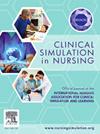Enhancing maternal/child content with augmented reality during simulation-based education: A study with prelicensure nursing students
IF 2.5
3区 医学
Q1 NURSING
引用次数: 0
Abstract
Background
Obstetric (OB) education faces challenges due to limited clinical placements and observation-only opportunities. Simulation-based experiences (SBE) can help bridge these gaps, providing realistic scenarios to enhance nursing students' understanding. Although Augmented Reality (AR) holds promise in nursing education, limited research evaluates its impact on OB content.
Aim
To evaluate completion time, post-simulation knowledge, perceived effectiveness, and side effects.
Methods
A post-test-only descriptive design was used with 119 prelicensure nursing students in a maternal/child course. Participants completed AR simulation scenarios of normal delivery and postpartum hemorrhage. Data collection included a researcher developed Knowledge Test, the simulation effectiveness tool-modified (SET-M) effectiveness tool-modifieas used with 11reality sickness questionnaire (VRSQ), and open-ended questions.
Results
Most students (94%) found the AR simulation beneficial prior to clinicals. The average post-simulation knowledge score was 7.95/10. SET-M results indicated an effective learning experience. VRSQ scores revealed mild oculomotor symptoms. No data could be analyzed for completion time or open-ended responses.
Conclusions
AR-enhanced Simulation-based experiences (SBE) is a valuable tool in OB education and may help address knowledge gaps. Further research is needed to explore its broader educational impact.
在基于模拟的教育中增强现实技术增强母婴内容:一项针对护理学预科学生的研究
由于有限的临床实习和仅观察的机会,产科教育面临着挑战。基于模拟的体验(SBE)可以帮助弥合这些差距,提供真实的场景来增强护理学生的理解。虽然增强现实(AR)在护理教育中有希望,但有限的研究评估其对OB内容的影响。目的评估完成时间、模拟后知识、感知有效性和副作用。方法采用仅限考试后的描述性设计,对119名妇幼课程的准护士进行调查。参与者完成了正常分娩和产后出血的AR模拟场景。数据收集包括研究人员开发的知识测试,与现实疾病问卷(VRSQ)一起使用的模拟有效性工具修改(SET-M)有效性工具修改(SET-M)和开放式问题。结果大多数学生(94%)认为AR模拟在临床前是有益的。模拟后知识平均得分为7.95/10。SET-M结果表明学习经验有效。VRSQ评分显示轻度动眼病症状。没有数据可以分析完成时间或开放式答复。结论sar增强模拟体验(SBE)是一种有价值的OB教育工具,可以帮助解决知识差距问题。需要进一步研究以探索其更广泛的教育影响。
本文章由计算机程序翻译,如有差异,请以英文原文为准。
求助全文
约1分钟内获得全文
求助全文
来源期刊

Clinical Simulation in Nursing
NURSING-
CiteScore
5.50
自引率
15.40%
发文量
107
期刊介绍:
Clinical Simulation in Nursing is an international, peer reviewed journal published online monthly. Clinical Simulation in Nursing is the official journal of the International Nursing Association for Clinical Simulation & Learning (INACSL) and reflects its mission to advance the science of healthcare simulation.
We will review and accept articles from other health provider disciplines, if they are determined to be of interest to our readership. The journal accepts manuscripts meeting one or more of the following criteria:
Research articles and literature reviews (e.g. systematic, scoping, umbrella, integrative, etc.) about simulation
Innovative teaching/learning strategies using simulation
Articles updating guidelines, regulations, and legislative policies that impact simulation
Leadership for simulation
Simulation operations
Clinical and academic uses of simulation.
 求助内容:
求助内容: 应助结果提醒方式:
应助结果提醒方式:


